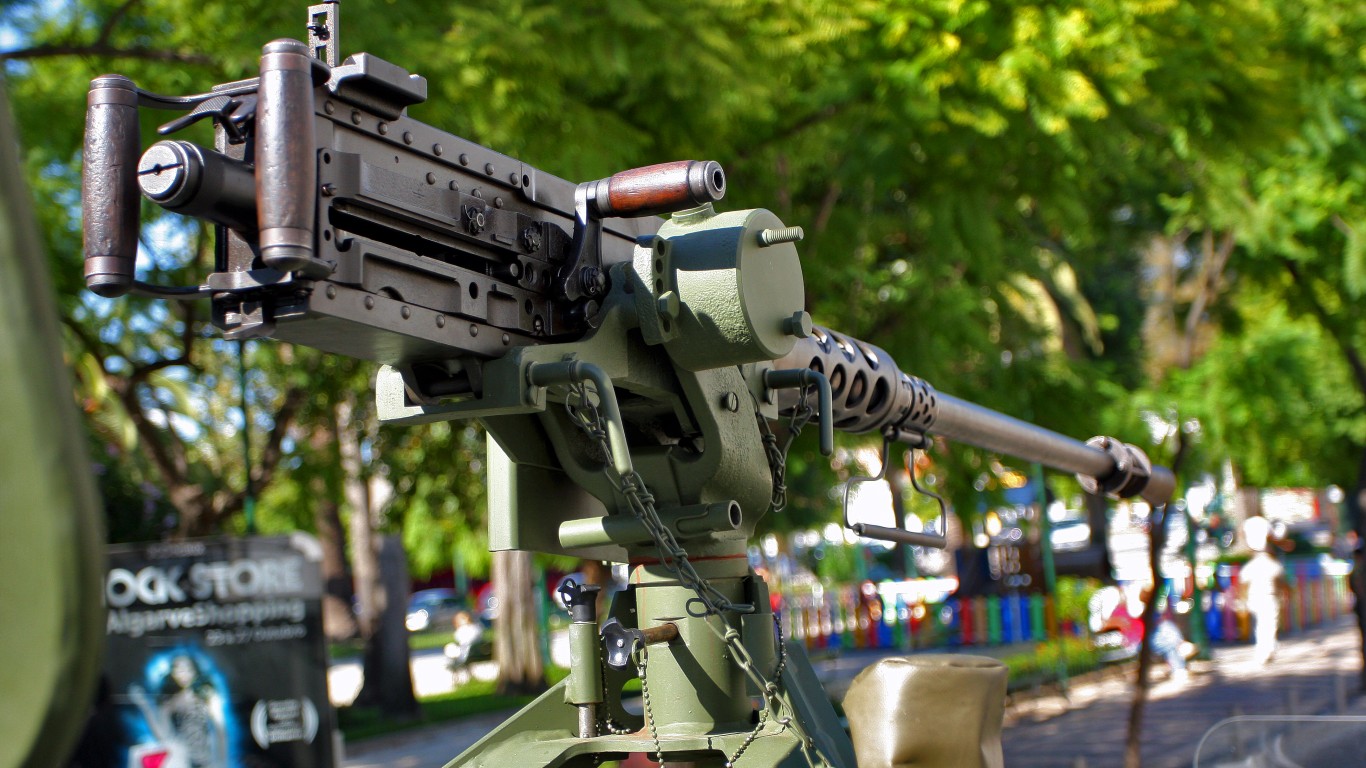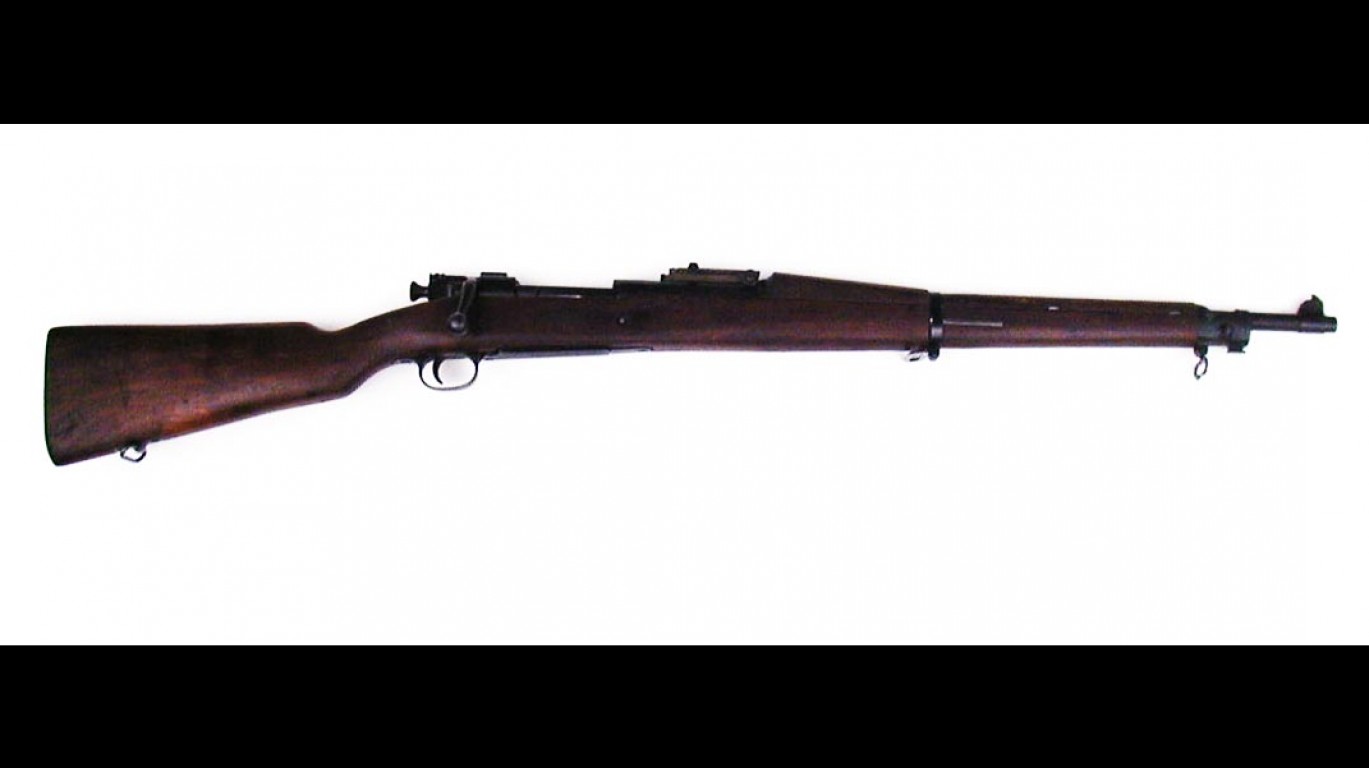
On Oct. 4, 2022, the most advanced aircraft carrier ever made, the USS Gerald R. Ford, departed from its Norfolk, Virginia, berth in its first major deployment – conducting training and operations alongside nine allied nations in the Atlantic. The Ford Class carrier will gradually replace the country’s 10 Nimitz-class flattops, which first hit the waves in 1975, making them one of the oldest pieces of U.S. military hardware still in service. (These are the US Navy’s oldest ships and submarines.)
Despite the size and expense of an aircraft carrier — the USS Gerald R. Ford cost $13.3 billion — 50 years is not a very long life cycle compared to other much smaller, much simpler pieces of American military hardware. Many of the U.S. military’s weapons from transport helicopters to rotary cannons to strategic bombers, have had longer life cycles.
To determine America’s oldest weapons that are still in use, 24/7 Wall St. consulted a range of sources, including Military Factory, to ascertain the year hardware and weapons were put into service. The weapons are ranked by the year they were first used by the U.S. military, from most to least recent. We also found information on weapon use and their original designer/manufacturer. Some weapons on this list are no longer used in combat but still used for military drills and ceremonial purposes. Some of the weapons on this list have been upgraded over the years, but if they maintained the name and the basic design, they were considered for the list.
Many of the weapons on this list have changed a great deal since they first saw service. They have been upgraded and modified with the latest technology. In many cases their appearance has changed a great deal, but you can still recognize the original design in the latest version. The M-14,
The list includes the UH-1 Iroquois “Huey,” first used in 1959 and featured in so many Vietnam War films. It also includes the B-52 strategic bomber, which took to the skies in 1954 and has since changed from its initial role as a nuke-dropper. Two terrifying machine guns designed by legendary arms maker John Browning, also made the list. They were introduced to U.S. soldiers way back in 1919. (These are the 18 deadliest weapons of all time.)
Some utilitarian non-combatant pieces of hardware are also listed, like two military-grade Caterpillar earth movers and an armored frontline “tow truck,” the M88 Hercules, that began service in the early ‘60s and was used to extricate broken or stuck tanks and other armored vehicles under fire during the Vietnam War.
Here are America’s 32 oldest military weapons still in service.

32. M224 LWCMS
> Year put into service: 1978
> Type: Mortar
> Designer/original manufacturer: US Military
The M224 Lightweight Company Mortar System replaced the M2 and M19 mortars that were used in World War II. The M224 can fire a 60mm mortar at an effective range of up to about 3,500 meters, nearly double that of its predecessor. It is lighter, too, weighing in at 37.5 pounds. It can also fire all types of the older ammunition at a sustained 20 rounds per minute, operated by a three-person crew.
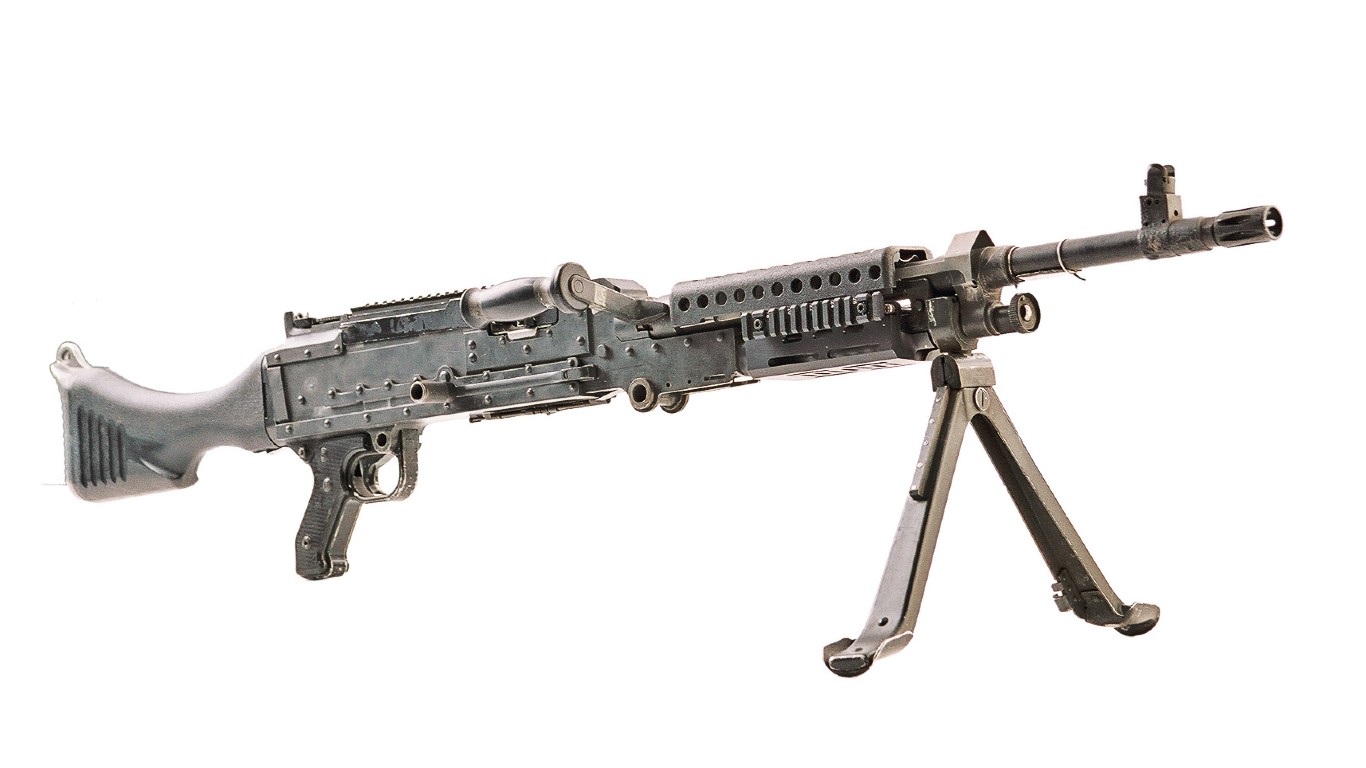
31. M240
> Year put into service: 1977
> Type: General-purpose machine gun
> Designer/original manufacturer: Fabrique Nationale
Based on the Fabrique Nationale MAG, an earlier general purpose machine gun of Belgian design, the M240 is a staple of the U.S. Army and Marine Corps, able to fire standard 7.62x51mm NATO rounds at extended ranges. The modern variant is lighter, and the weapon’s versatility ensures it would likely remain a service weapon for the foreseeable future.
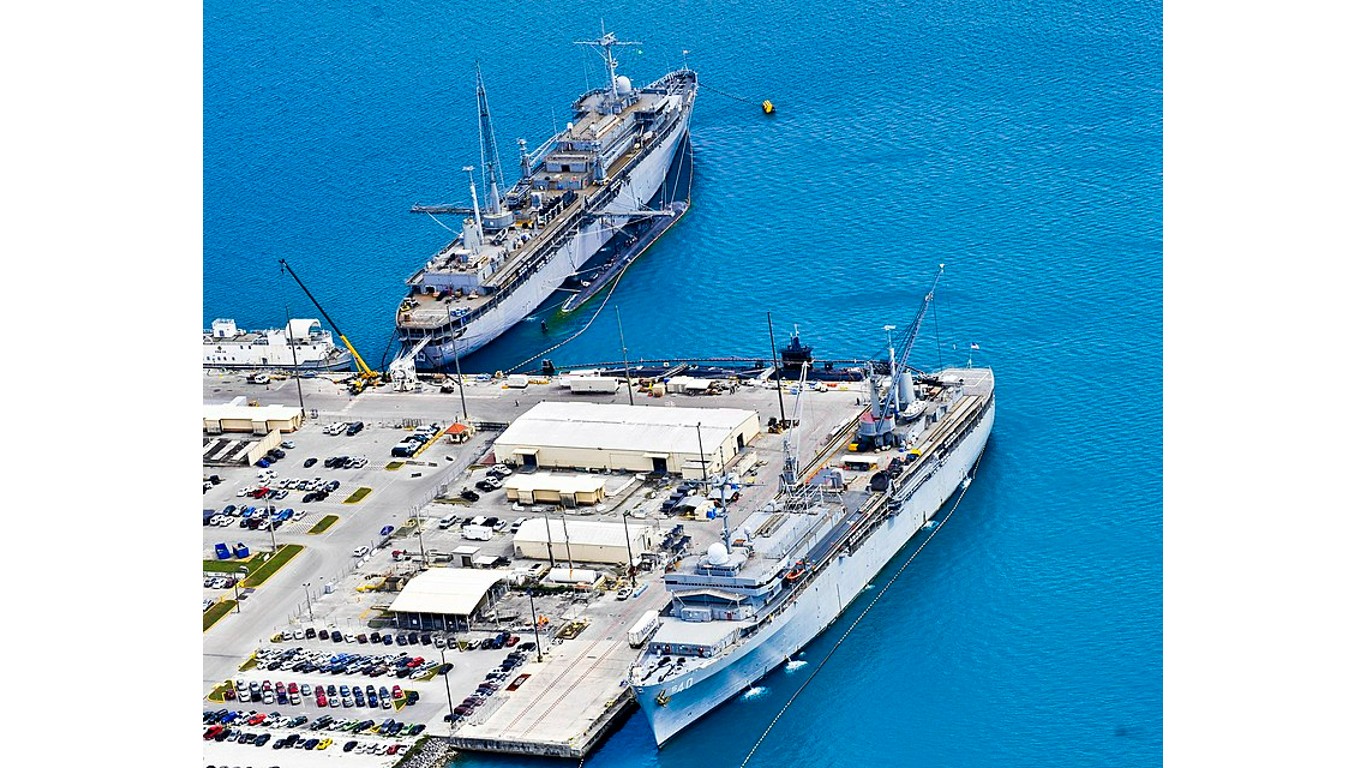
30. Emory S. Land Class Submarine Tender
> Year put into service: 1977
> Type: Submarine tender
> Designer/original manufacturer: Lockheed
The Emory S. Land was the first of the latest class of submarine tenders, subs that offer supplies and support to Los Angeles class nuclear attack submarines and other vessels, including surface ships. These subs are floating workshops that can conduct maintenance operations at sea or in port, and they carry extra fuel, ordnance, other supplies, and can accommodate relief crews.
[in-text-ad-2]

29. Nimitz Class Aircraft Carrier
> Year put into service: 1975
> Type: Nuclear-powered aircraft carrier
> Designer/original manufacturer: Newport New Shipbuilding
The 10 Nimitz class aircraft carriers of the U.S. Navy have been the largest warships ever built until the Gerald R. Ford class aircraft carrier, the first of which was deployed by the U.S. Navy on Oct. 4, 2022. When fully loaded, the 317-meter (1,040-foot) long warship typically accommodates about 4,700 personnel, including 1,500 aircrew members, and it can carry up to 60 aircraft with a maximum speed of more than 30 knots.
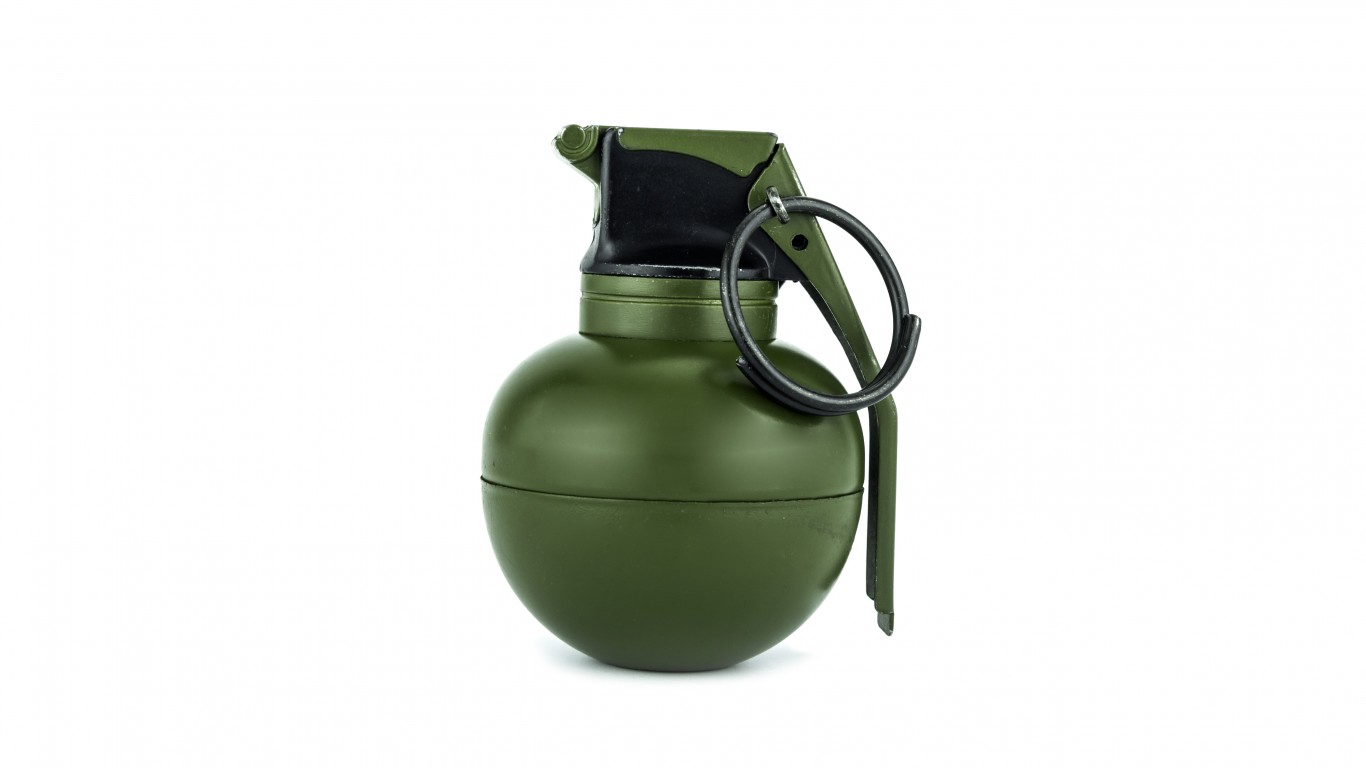
28. M67
> Year put into service: 1968
> Type: Hand grenade
> Designer/original manufacturer: US Military
The M67 2.5-inch diameter sphere-shaped fragmentation grenade supplements small arms fire in close combat. The grenade detonates four to five seconds after the release of the safety lever, with a lethal blast radius of 5 meters (16 feet) and a good chance of inflicting injuries up to three times that radius. It became the most widely used frag grenade of U.S. troops in the Vietnam War after 1969.
[in-text-ad]
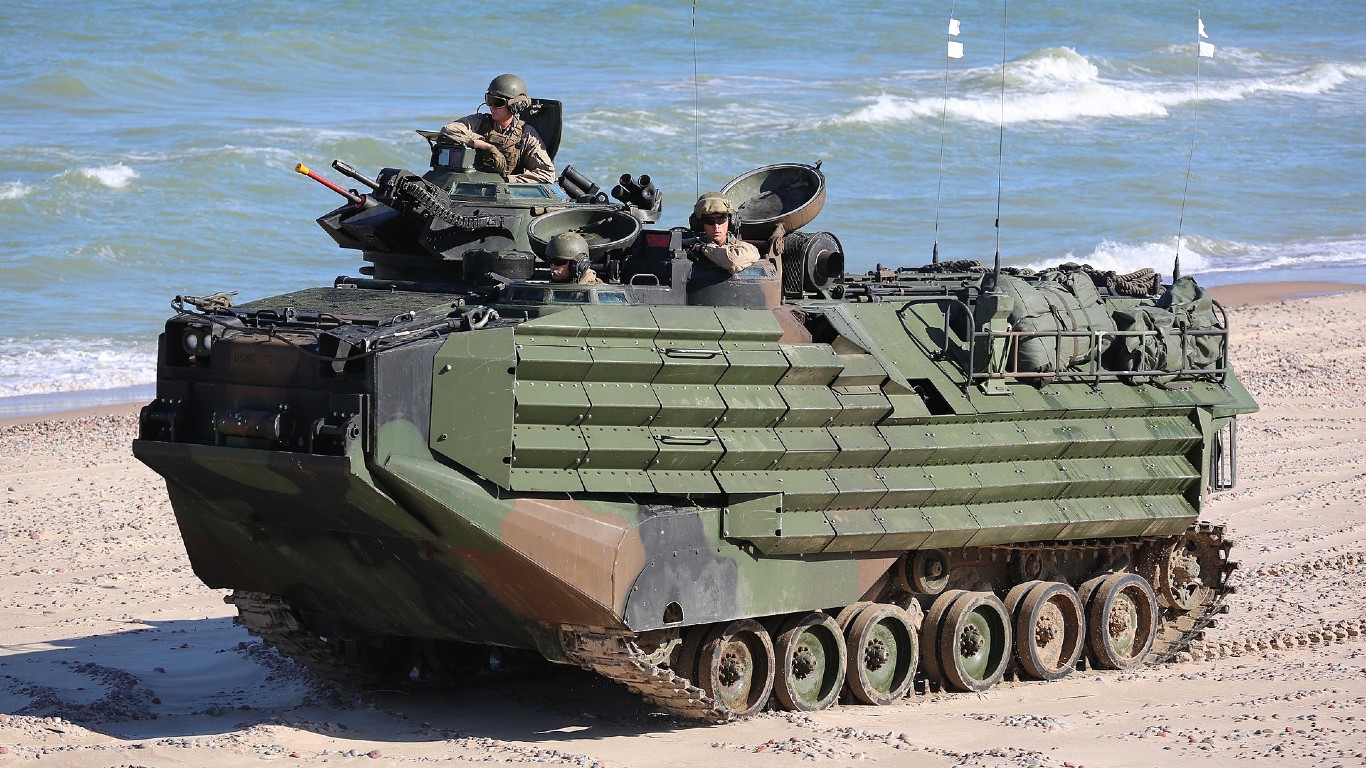
27. AAV-7
> Year put into service: 1972
> Type: Amphibious armored personnel carrier
> Designer/original manufacturer: United Defense
In the late 1960s, the Pentagon determined that the U.S. armed forces were in need of an armored personnel carrier with both sea-going and terrestrial mobile capabilities, a better vehicle than the one used to land troops on the beaches of Normandy during D-Day. The result was the AAV-7, aka the “Battle Bus,” a mainstay of the U.S. Marine Corps that proved effective in moving troops from sea to land under combat situations.

26. USS Blue Ridge Class Amphibious Command Ship
> Year put into service: 1971
> Type: Amphibious command and control ship
> Designer/original manufacturer: US Military
The USS Blue Ridge Class Amphibious Command Ship is the only vessel designed from the ground up to act as a command and control center for fleet leaders of the U.S. Navy and Marine Corps. Earlier versions were too slow to keep up with amphibious assault forces. The ship’s crew includes about 560 enlisted personnel and 34 officers. The existing ships are expected to remain in service until 2039.
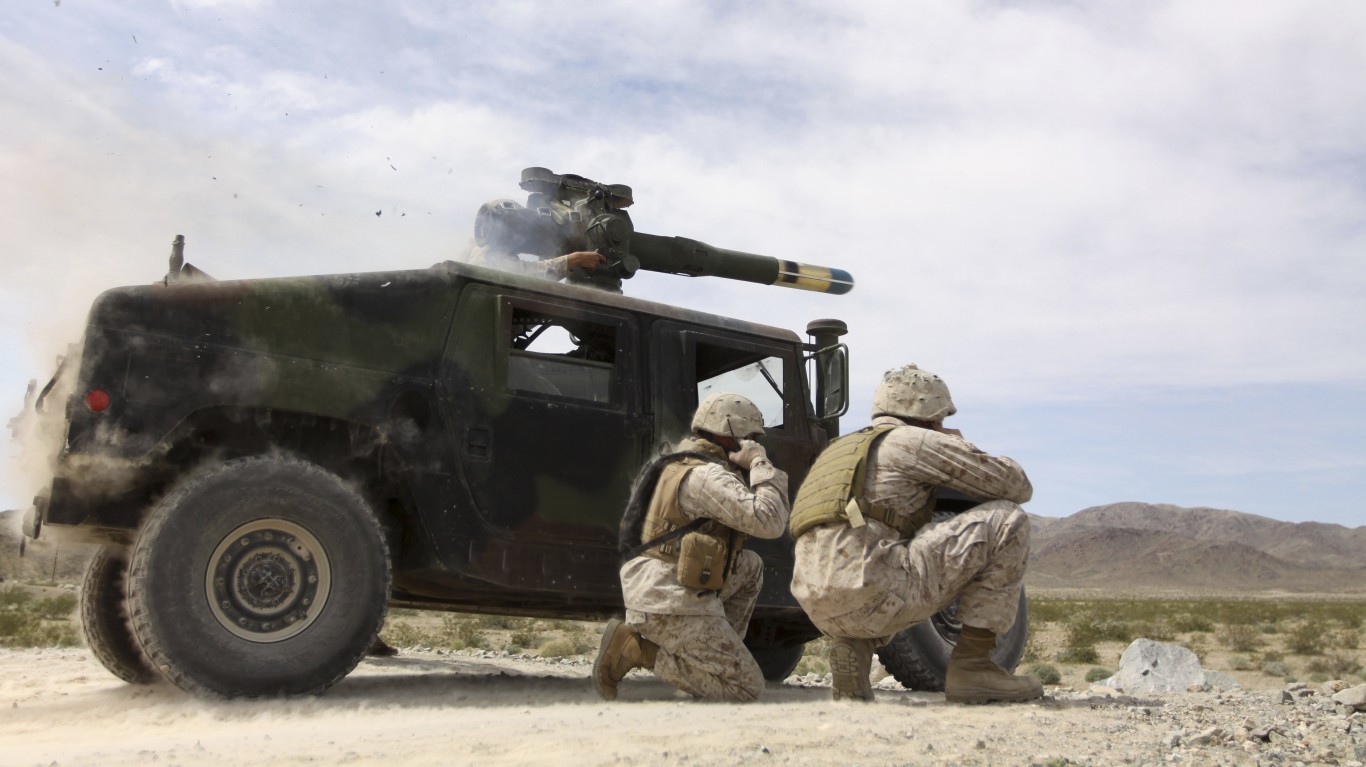
25. BGM-71 TOW
> Year put into service: 1970
> Type: Anti-tank missile
> Designer/original manufacturer: Hughes Aircraft Company
The BGM-71 TOW is one of two missiles on this list of America’s oldest weapons that are still in service. Research and development of wire-guided missiles date back to the 1950s in France. These missiles use thin, unspooling wires to guide them toward their nearby targets. The TOW system is one of the most widely used anti-tank missiles. TOWs can be manually carried or mounted on vehicles, and they have proven effective against mobile targets thousands of meters away.
[in-text-ad-2]
24. Remington 870
> Year put into service: 1969
> Type: Shotgun
> Designer/original manufacturer: Remington
Familiar to gun owners, the Remington 870 is also the oldest shotgun that’s still in use by the U.S. military thanks to its dependability and hard punch. The Marine Corps sought in the late ’60s to replace older World War II-era shotties. The result was the Model 870 Mark 1, which is basically similar to the civilian version of the 870 but fitted with a bayonet adapter, rifle sights, and an extended magazine of eight rounds, including one in the chamber.
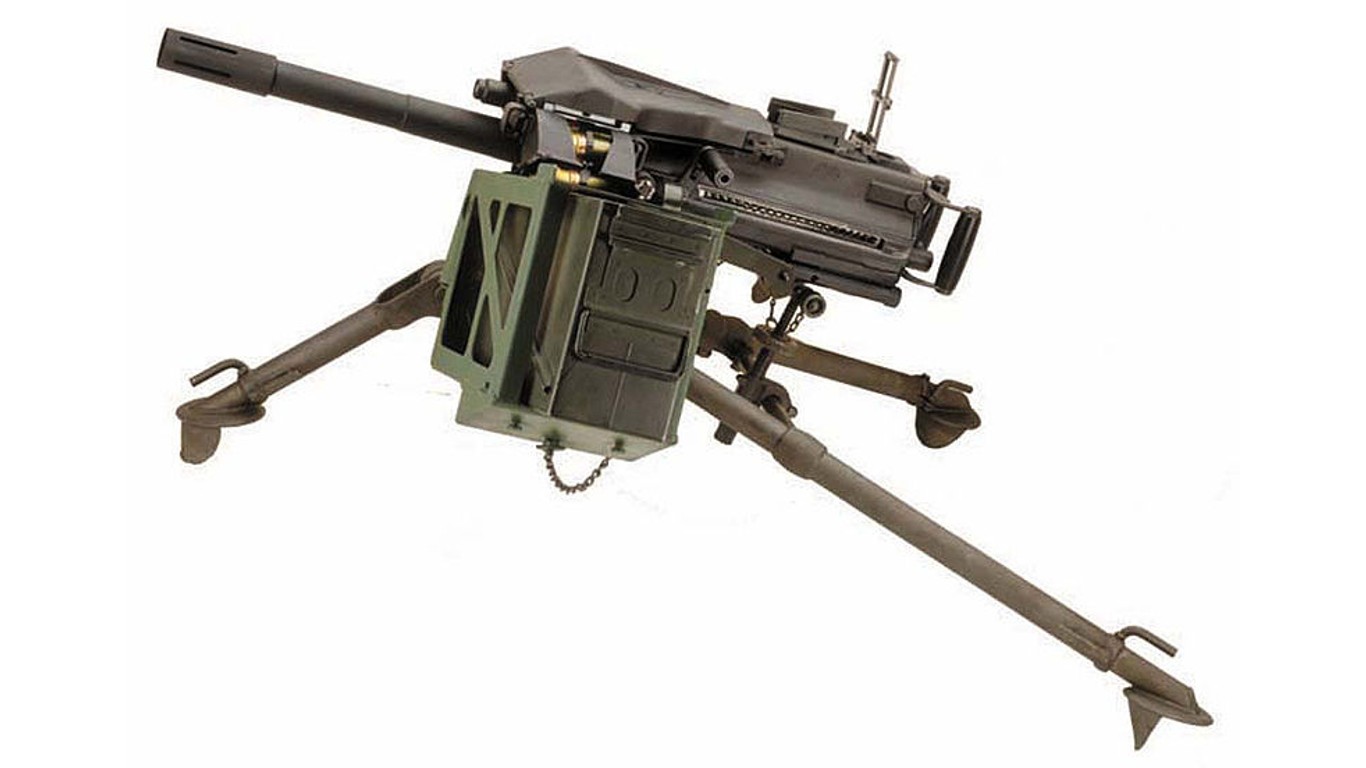
23. Mk 19
> Year put into service: 1968
> Type: Grenade launcher
> Designer/original manufacturer: Saco Defense
The Mk 19 grenade launcher is a potent weapon capable of firing 40mm high explosive grenades at a rate of up to 60 rounds per minutes (40 rpm for sustained fire) that can penetrate up to 50mm of armor plating with a direct hit. The heavy vehicle- or tripod-mounted weapon is so potent it is dangerous to use against targets closer than 75 meters (82 yards) away.
[in-text-ad]
22. M197 Vulcan
> Year put into service: 1967
> Type: Rotary cannon
> Designer/original manufacturer: General Dynamics
The electric three-barrel M197 is the newer of the three rotary “Gatling” guns on this list. It was developed primarily to arm U.S. Army gunboat helicopters with a better weapon than the ones used during the Vietnam War, which fired smaller 7.62mm NATO cartridges. The M197 Vulcan is typically mounted on the nose of modern attack helicopters, fed by a 700-round, chain-linked magazine of large 20mm rounds. Typically, the gun is fired in bursts of 30 to 50 rounds. Modern versions replace the chain-linked magazine with a chainless system that is less prone to jamming.
21. CH-47 Chinook
> Year put into service: 1966
> Type: Transport helicopter
> Designer/original manufacturer: Boeing
The easily recognized tandem rotor helicopter workhorse made its debut hauling artillery to firebases during the Vietnam War. It remains a useful way to quickly move heavy equipment and personnel. It proved particularly useful during the war in Afghanistan as it was able to fly heavy equipment above the peaks of the mountainous landscape better than other helicopters in the U.S. arsenal.

20. GE M134 Minigun
> Year put into service: 1963
> Type: Rotary medium machine gun
> Designer/original manufacturer: General Electric
The M134 Minigun is the vehicle-mounted version of the M61 Vulcan six-barrel Gatling-style rotary gun that has been affixed to aircraft since 1946. These brutal “suppression” weapons can spew between 2,000 and 6,000 rounds per minute, obliterating almost anything in their way. Unlike the Hollywood depiction of the Minigun, where brawny action stars wield them against the bad guys, Miniguns require heavy external power packs, which necessitates them to be affixed to air, land, or sea vehicles.
[in-text-ad-2]
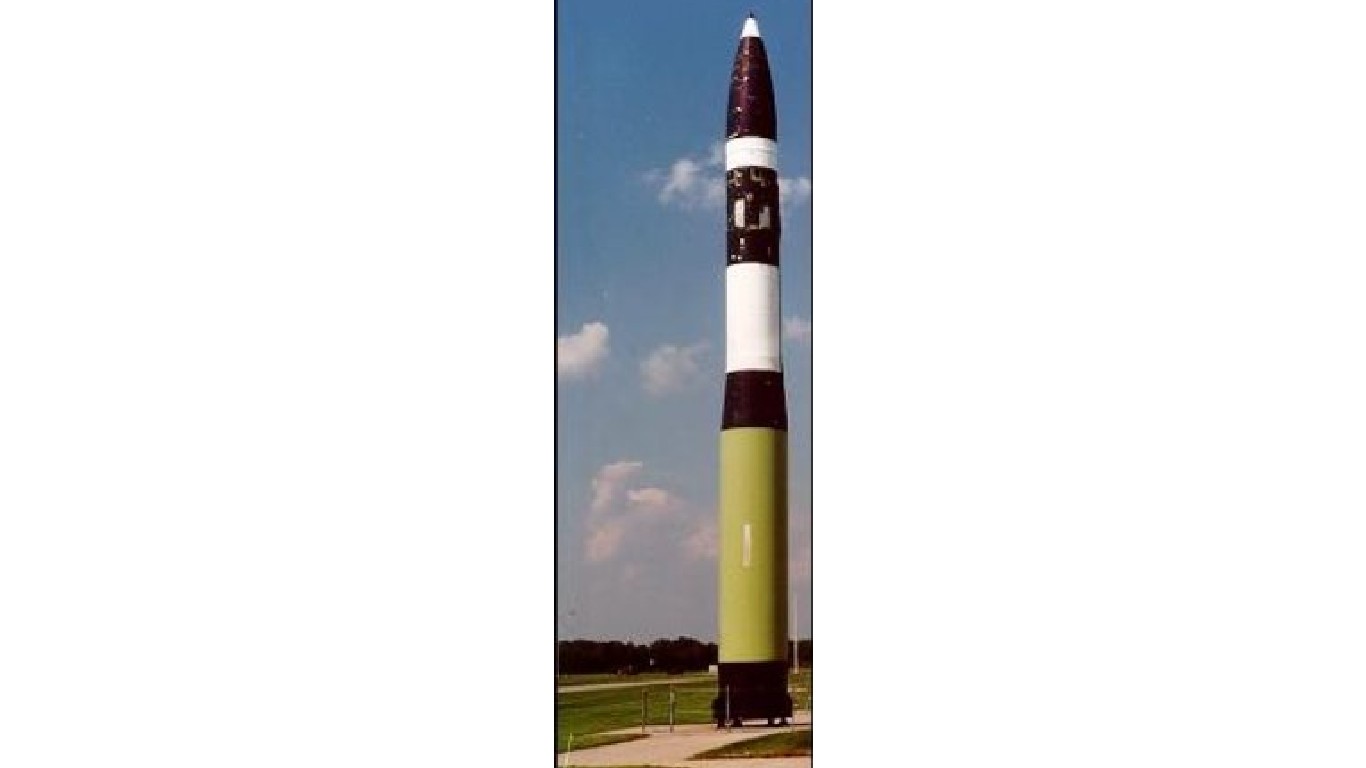
19. LGM-30 Minuteman
> Year put into service: 1962
> Type: Intercontinental ballistic missile
> Designer/original manufacturer: Boeing
The Minuteman was the first intercontinental ballistic missile capable of deploying multiple warheads for greater destructive power, and it continues to be an important part of the U.S. nuclear triad of sea, air, and land nuclear delivery system. The latest version, the Minuteman III, has a range of about 6,000 miles, and the U.S. Air Force maintains an estimated 450 of these ICBMs, which are based in Wyoming, Montana, and North Dakota. The Minuteman missiles are being replaced by the Sentinel system.
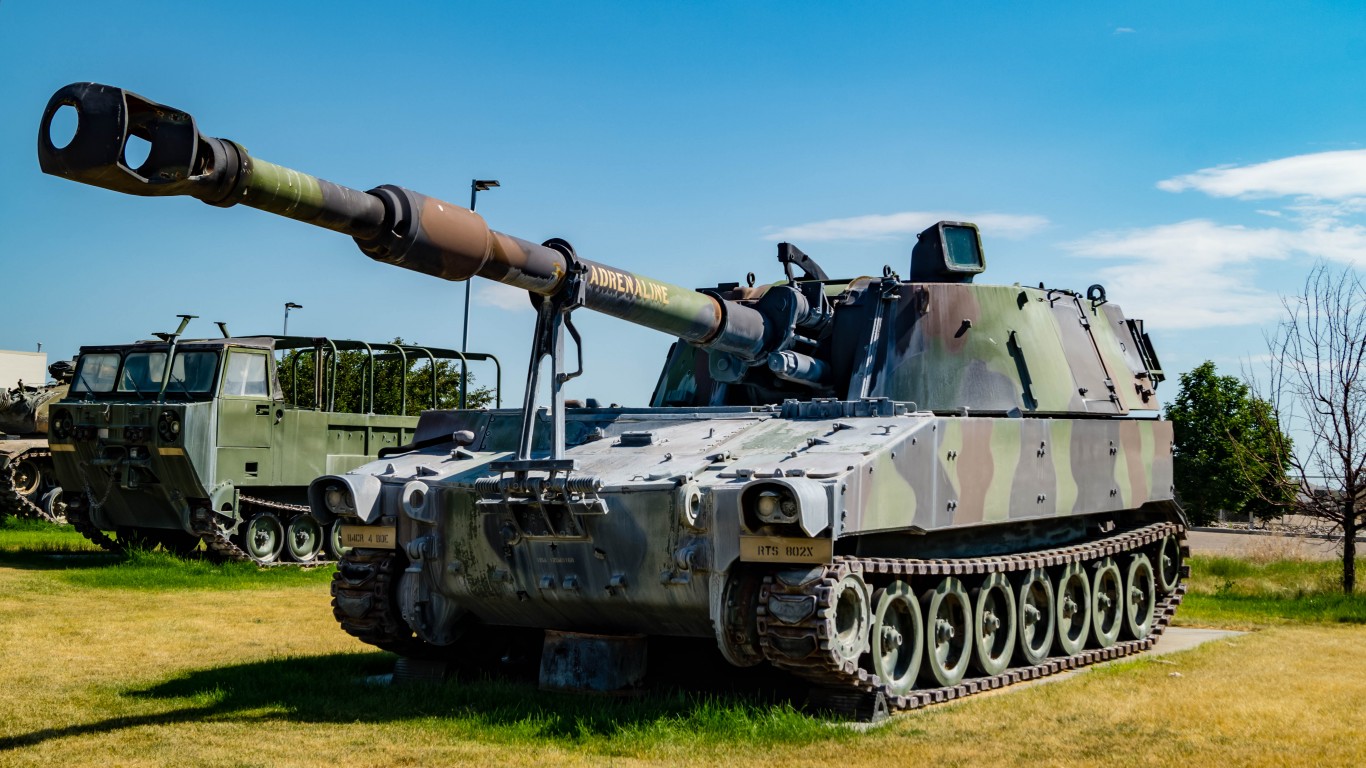
18. M109 Howitzer
> Year put into service: 1962
> Type: self-propelled artillery
> Designer/original manufacturer: United Defense
The 28-ton, 30-foot long M109 Paladin is a self-propelled artillery system that, as the name implies, does not require a tow vehicle like conventional artillery weapons. It is essentially a continuous track tank with a 155mm artillery gun as a turret. Operated by a six-person crew, the Paladin can lob six rounds per minute at targets up to 11 miles away. It is defended from close-range fire by a .50 caliber M2 heavy machine gun, another one of America’s oldest weapons that is still in service.
[in-text-ad]
17. M88 Hercules
> Year put into service: 1961
> Type: Armored recovery vehicle
> Designer/original manufacturer: Bowen McLaughlin York
The Hercules series Armored Recovery Vehicle is one of the world’s most powerful tow trucks. This armored support vehicle is basically a tank without a turret whose primary role is to recover damaged or stuck armored vehicles, including tanks, under fire. The Hercules is protected by a mounted .50 caliber machine gun and smoke grenade dischargers that can hide the vehicle in a cloud of white smoke.
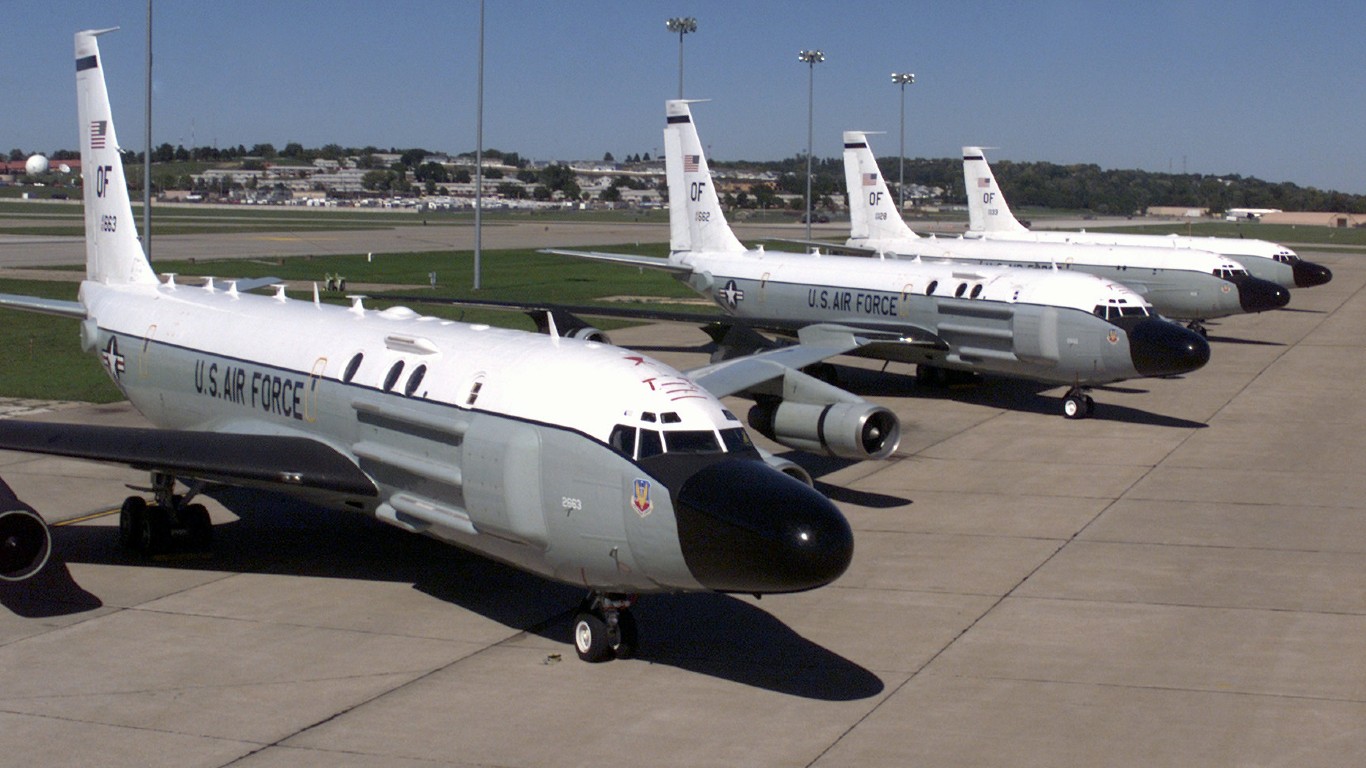
16. RC-135S Cobra Ball
> Year put into service: 1961
> Type: Reconnaissance aircraft
> Designer/original manufacturer: Boeing
The RC-135S Cobra Ball conducts missions under the direct order of the White House Joint Chiefs of Staff, collecting visual and electronic data on ballistic targets. The core task of this militarized Boeing 707 is to verify treaty compliance by collecting intelligence that is not acquirable by other means – intel that goes right to the president. A typical crew consists of two pilots and a navigator, plus a team of mission specialists, electronic warfare officers, and systems engineers. There are three still in use by the US Air Force.

15. M72 LAW
> Year put into service: 1961
> Type: Anti-tank rocket-propelled grenade launcher
> Designer/original manufacturer: FA Spinale, CB Weeks and PV Choate
During World War II, the Germans were the first to introduce the bazooka into combat. By the Vietnam War, the United States had developed an effective shoulder-fired lightweight anti-tank weapon, or LAW. The M72 series of disposable, single-shot rocket launchers can fire different kinds of ordnance used against tanks and other mobile land vehicles. The weapon has a dangerous backblast of a least 45 feet from the open back end of the firing tube. In 2018, the LAW received a major upgrade.
[in-text-ad-2]
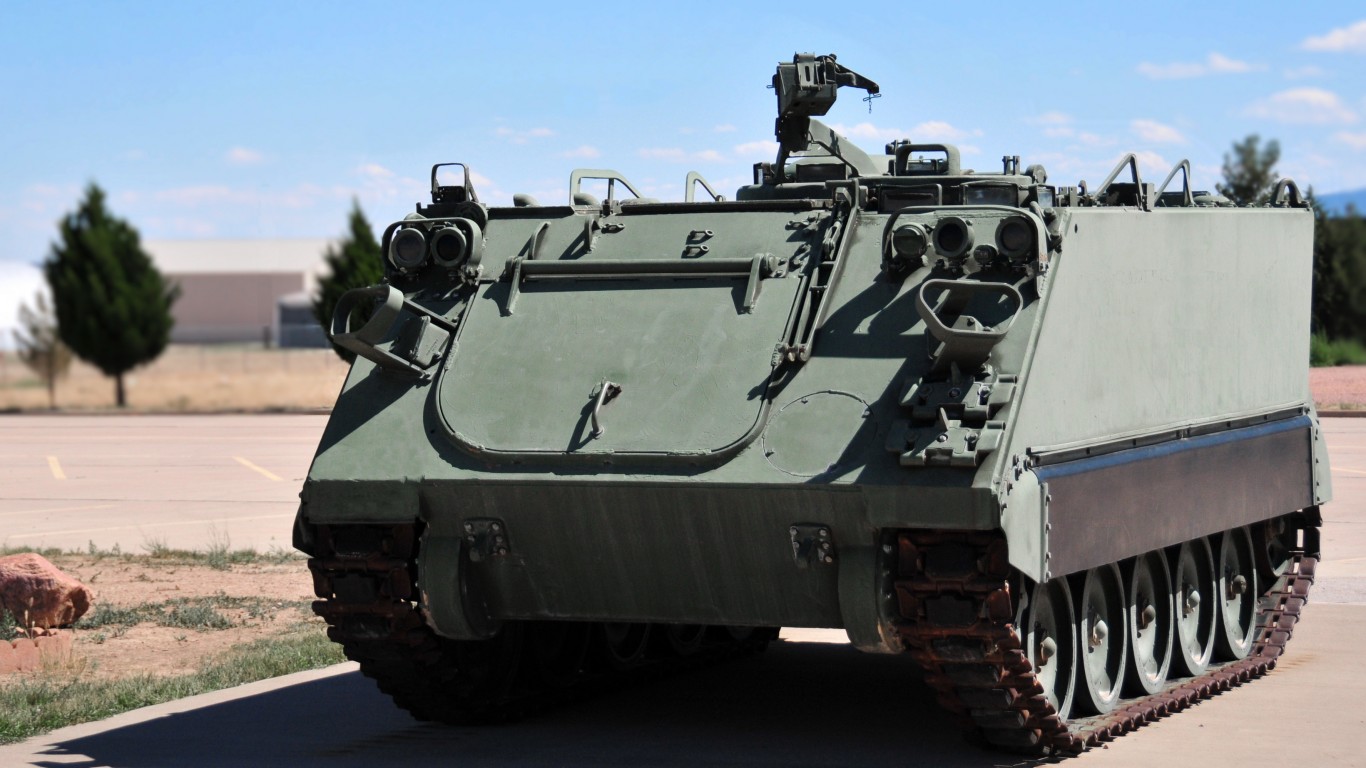
14. M113 APC
> Year put into service: 1960
> Type: Armored personnel carrier
> Designer/original manufacturer: FMC Corporation
The Vietnam War-era M113 armored personnel carrier has played an important role in moving Ukrainian soldiers during their defense against Russian invaders. This 12-ton tracked APC can travel at speeds up to 42 miles per hour, carrying 11 soldiers and a driver. The APC is protected by a mounted M2 .50 caliber machine gun and a 7.62mm M6 machine gun fired from inside the cabin. There are still some 5,000 in use by the United States.
13. M18A1 Claymore
> Year put into service: 1960
> Type: Directional fragmentation anti-personnel mine
> Designer/original manufacturer: Norman MacLeod
Named after a medieval Scottish sword, the Claymore is an antipersonnel mine armed with hundreds of 3.2-millimeter steel balls that spray out in a 60-degree arc to about 100 meters when the C4 explosive behind them is detonated. Unlike conventional mines, the Claymore stands upright, sending its blast horizontally instead of vertically. Claymores are typically set up to prevent ambushes or infiltration attempts by enemy forces. It is detonated by remote control when an ambush or infiltration is detected by a sentry.
[in-text-ad]

12. M14
> Year put into service: 1957
> Type: Battle rifle (currently used ceremonially)
> Designer/original manufacturer: Springfield Armory
The M14 rifle has long been retired as a service or basic training weapon. It was the last standard-issue rifle before it was replaced by more modern assault rifles, starting with the M16 in 1964. The semi-automatic M14 replaced the M1 Garand, a vital standard issue rifle of World War II and the Korean War. Firing NATO 7.62mm rounds, the M14 is a more powerful and accurate rifle than modern assault rifles, but the modern rifles are lighter and can spread bursts of fire over a wider range more rapidly than the M14. While not used in combat, it is still used as a ceremonial gun of the U.S. Tomb Guard.
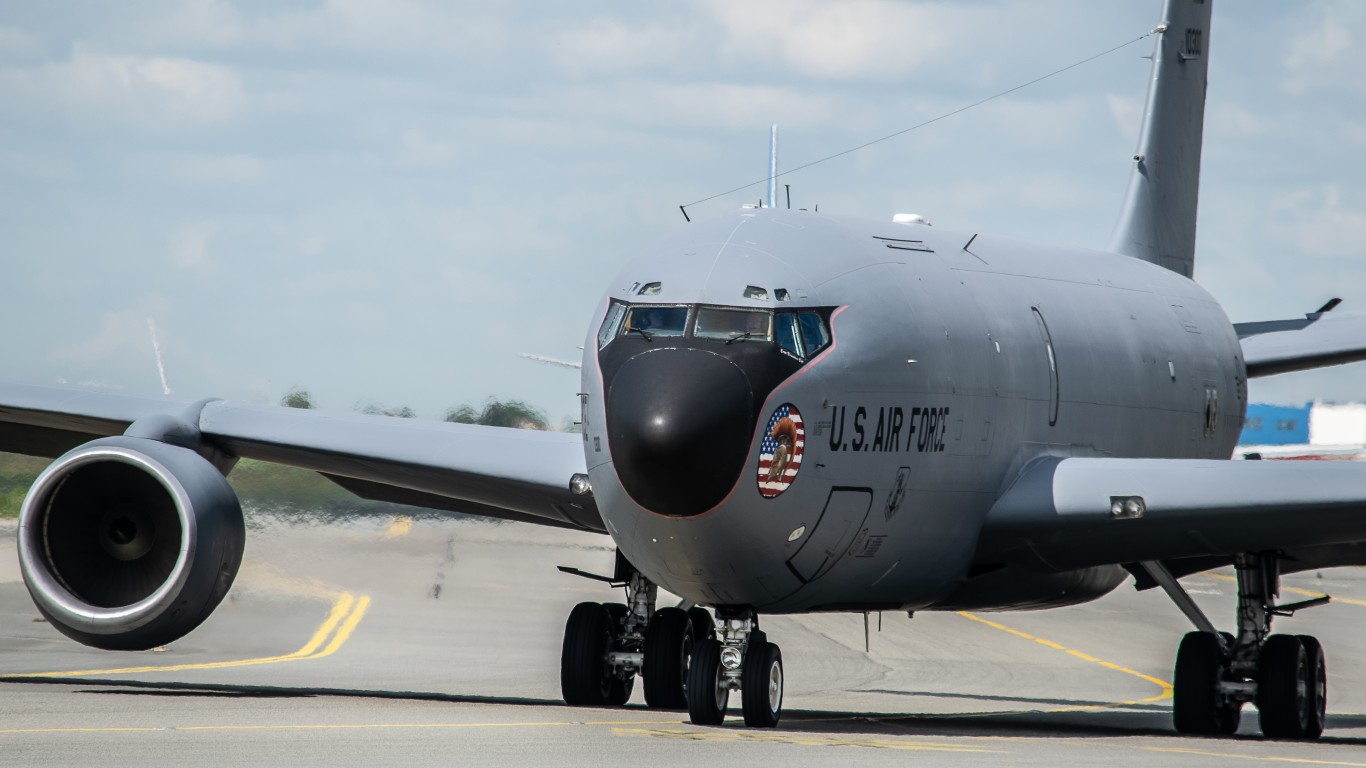
11. KC-135 Stratotanker
> Year put into service: 1957
> Type: Aerial refueling and transport aircraft
> Designer/original manufacturer: Boeing
The Stratotanker has played a simple but vital and technically complicated role as an aerial refueler for the U.S. Marine Corps, Navy, and Air Force aircraft. It has been used in every major U.S. conflict involving air support since the Vietnam War. The aircraft is also used to transport wounded personnel during aeromedical evacuations. The Stratotanker, developed by Boeing alongside its commercial Boeing 707, can carry up to 83,000 pounds of cargo, depending on the aircraft’s fuel cargo configuration.
[in-text-ad-2]
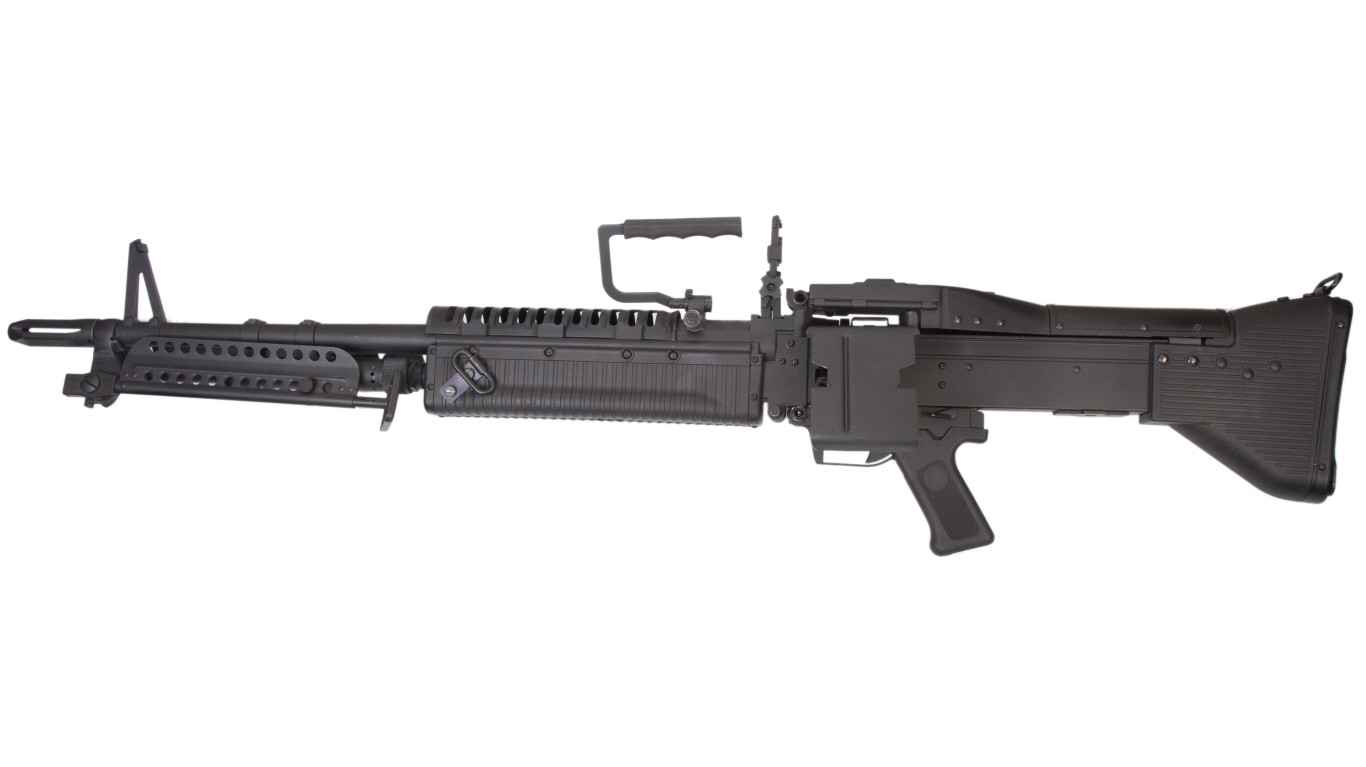
10. M60
> Year put into service: 1957
> Type: Medium machine gun
> Designer/original manufacturer: Saco Defense
Weighing just 23 pounds, this fearsome general purpose machine gun became one of the most iconic weapons of the U.S. in Vietnam. The 42-inch-long weapon, nicknamed “The Pig,” could spit out a sustained rate of fire at 100 rounds per minute, but this extreme rate meant the barrel had to be swapped out about every 10 minutes in combat situations. The Pig’s belt-loaded ammo could be discharged by one very strong soldier, but the gun requires a team of three to transport, set up, and load. While it has been mostly phased out, it is still used on the Sikorsky Seahawk helicopter.
9. Caterpillar D9
> Year put into service: 1955
> Type: Bulldozer
> Designer/original manufacturer: Caterpillar
Often a key element of military engagement is the need to eliminate obstructions like natural and human-made barriers and booby traps or to create sand mounds and recover stuck armored vehicles. This is where a good old civilian Caterpillar bulldozer comes into play. The commercial version is painted in Caterpillar’s trademarked yellow, while the military version is painted to blend with the environment. The military D9 is also armored to protect its two-person crew from small arms fire and artillery shell fragments, and it can be armed with a mounted machine gun.
[in-text-ad]
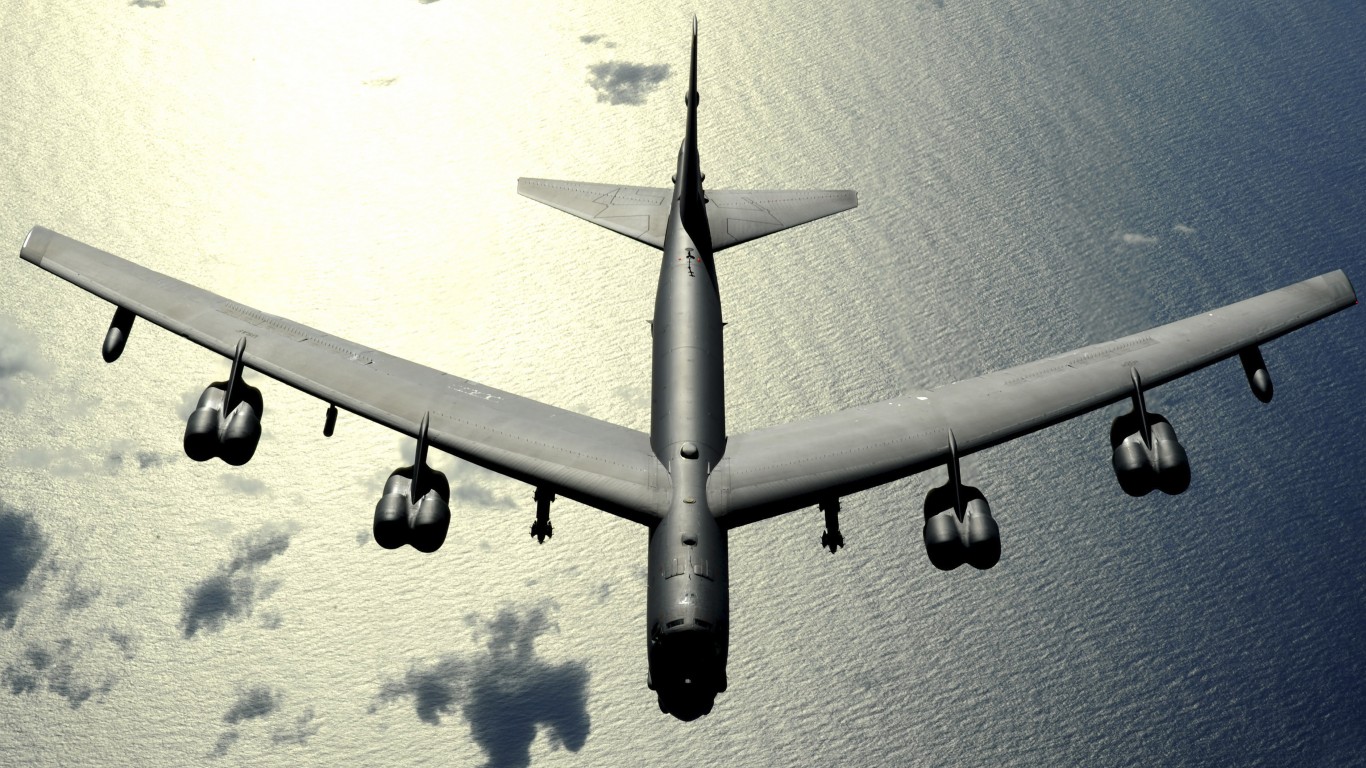
8. B-52 Stratofortress
> Year put into service: 1954
> Type: Strategic bomber
> Designer/original manufacturer: Boeing
The first long-range heavy bomber of the U.S. armed forces remains in service, even though its initial function as a potential nuclear bomb dropper has changed. The B-52 is used as a conventional lower-altitude bomber that can also be deployed for extended range transport of ballistic and cruise missiles. The current modern version of the B-52, equipped with advanced communication systems and real-time intelligence feeds, has a lifespan that extends past 2040.
7. C-130 Hercules
> Year put into service: 1954
> Type: Transport aircraft
> Designer/original manufacturer: Lockheed
The C-130 is one of the U.S. military’s massive airlift planes, and it holds the record for the longest continuous production run of a military aircraft. This versatile behemoth can be modified to operate as a special operations gunship or for the insertion and extraction of special ops units. The latest version, the more spacious C130J Super Hercules, features upgraded avionics, requires a smaller crew than its predecessors to operate, and flies faster.

6. M15 Mine
> Year put into service: 1950
> Type: Anti-tank blast mine
> Designer/original manufacturer: US Military
First used in the Korean War, the M15 is a larger and more potent version of the M6 anti-tank mine developed shortly after WWII and of the M1 used against Nazi tanks. It has since been replaced by the modern and lighter M19 mine, but the U.S. still keeps them in stock as they are proven effective in disabling battle tanks and armored or unarmored vehicles. Enemy tank crews are likely to survive an M15 anti-tank mine, but crew in less protected vehicles would be less protected.
[in-text-ad-2]

5. M61 Vulcan
> Year put into service: 1946
> Type: Rotary cannon
> Designer/original manufacturer: General Electric
The hydraulically or pneumatically operated 20mm six-barrel gatling gun-style rotary cannon has been an effective weapon for more than 75 years. The modern variant is capable of firing about 6,000 rounds per minute, with each barrel firing one of every six rounds, thus reducing overall wear and heat buildup. The M61 is mounted on fighter aircraft like the F-16 and F-22 Raptor. Though the M61 is huge, it is smaller than the massive 30mm GAU-9/A rotary cannon mounted on the nose of the A-10 “Warthog” Thunderbolt II.
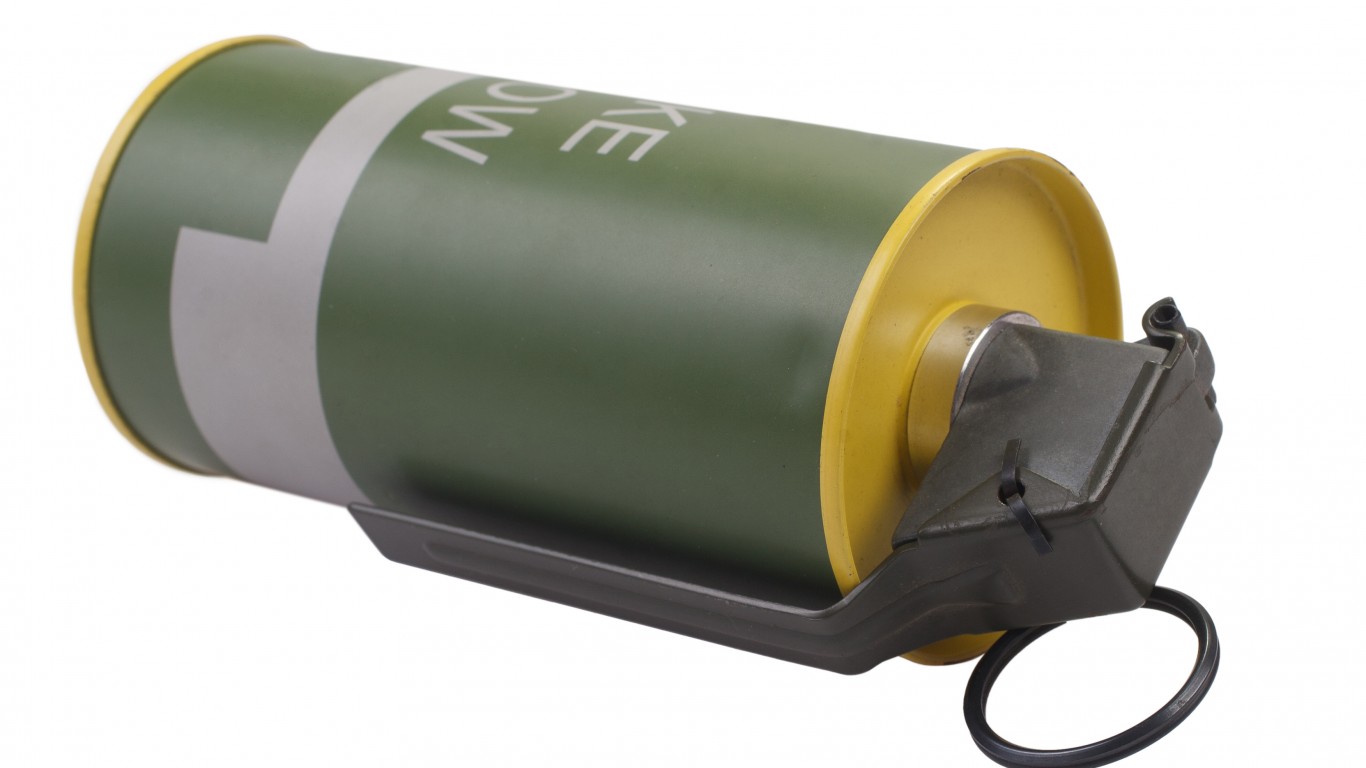
4. M18 Smoke Grenade
> Year put into service: 1942
> Type: Smoke grenade
> Designer/original manufacturer: US Military
A few of the oldest military weapons that are still in service today are used because they provide a basic role. As the saying goes: “If it ain’t broke, don’t fix it.” The M18 smoke grenade fits this category, as it is still in use after 80 years. It is the smokier version of the M16 used during WWII. The M16 could emit smoke in seven different colors, but the military determined that only four colors were necessary. The smoke of the M18 is commonly green, yellow, red, or white, though other colors are available.
3. M2 Browning
> Year put into service: 1919
> Type: Heavy machine gun
> Designer/original manufacturer: John Browning
The recoil-operated, air-cooled M2 Browning is one of four machine guns on this list, as well as one of the oldest military weapons that are still in service — more than century after its debut. The relative simplicity and lethality of rapid-fire weapons like the M2 have kept them around since the technology emerged in the early 1900s. Heavy machine guns during WWI put an end to the hitherto common practice of mass infantry charges. The modern M2 can fire up to about 800 rounds per minute with a maximum range of 6,800 meters and a more accurate maximum effective range of about 2,000 meters.
2. M1911
> Year put into service: 1911
> Type: Semi-automatic pistol
> Designer/original manufacturer: John Browning
The genius of the legendary small arms and machine gun designer John Browning (1855-1926) is illustrated by the fact that three of his weapons are still used today (in their modern variants), more than a century later: the M2 and M1919 machine guns and the M1911 .45 caliber semi-automatic pistol. This powerful gun remained a primary handgun until it was replaced in the 1980s with the Beretta M9, an effective 9mm pistol. U.S. Marine Corps Special Operations units still use the M1911 under the modern M45 designation.
1. M1903 Springfield
> Year put into service: 1903
> Type: Bolt-action rifle
> Designer/original manufacturer: Springfield Armory
Like the M14, the M1903 Springfield is one of the weapons used by the Tomb Guard in a ceremonial fashion, wielded “mostly for show,” as described by the Society of the Honor Guard. The use of these two rifles, and others, in this role is owed mostly to their important roles in past wars. The M1903 was the standard military infantry rifle in WWI. Its service was continued into WWII, but it saw limited use in Korea and Vietnam.
Thank you for reading! Have some feedback for us?
Contact the 24/7 Wall St. editorial team.
 24/7 Wall St.
24/7 Wall St.

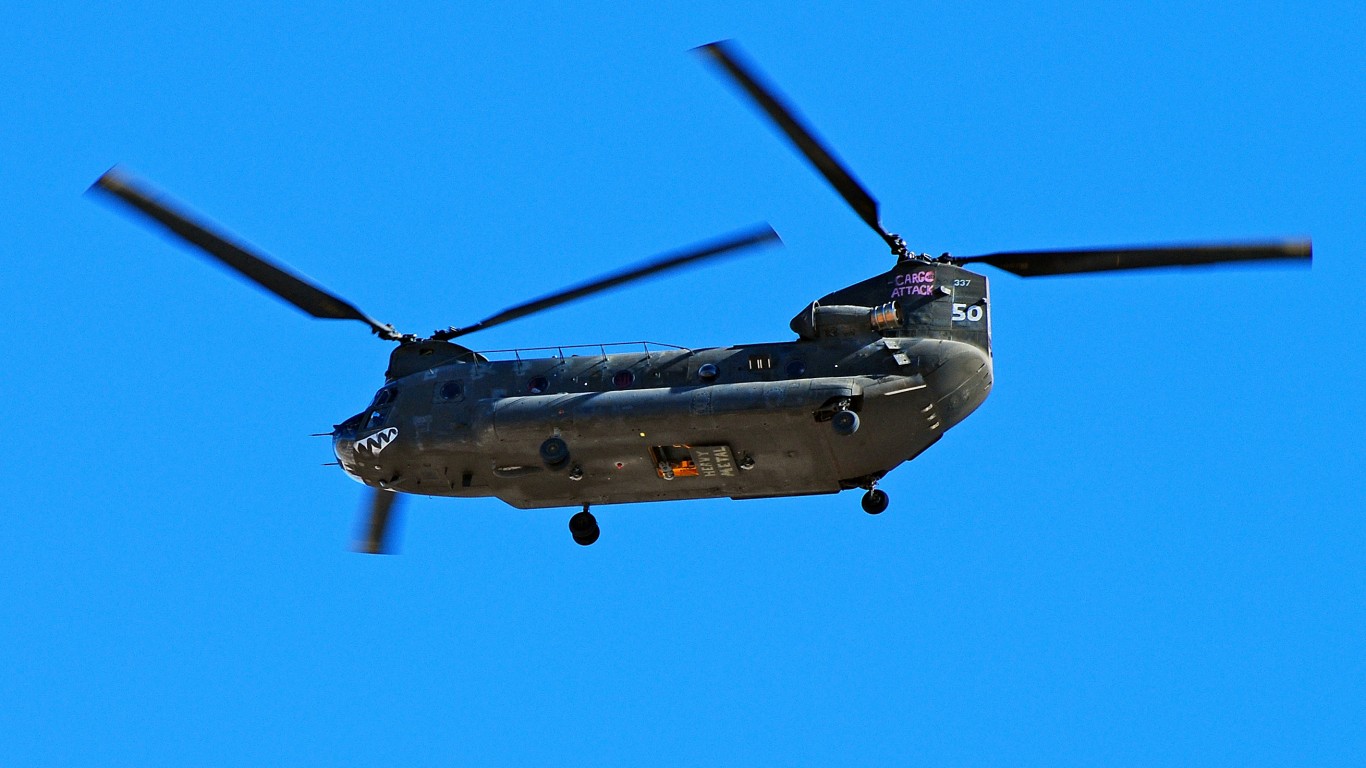

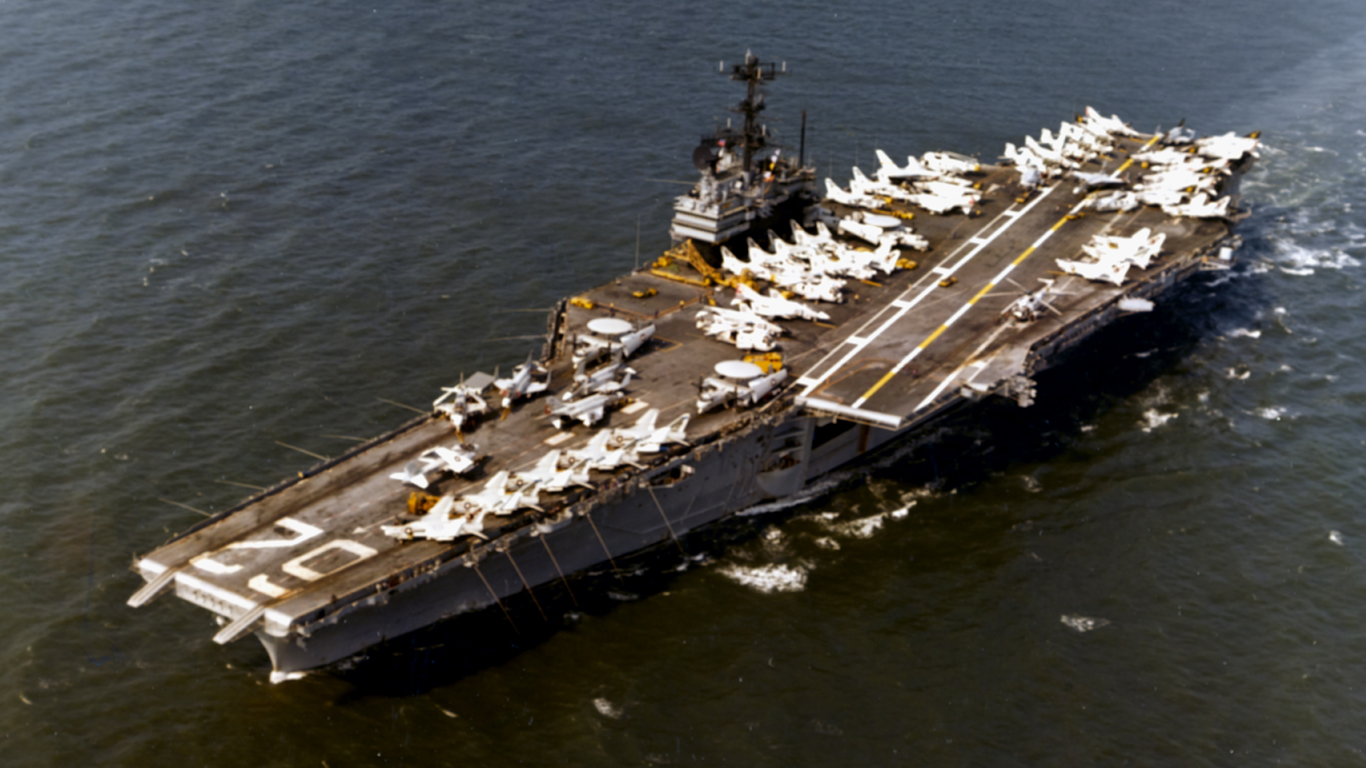 24/7 Wall St.
24/7 Wall St.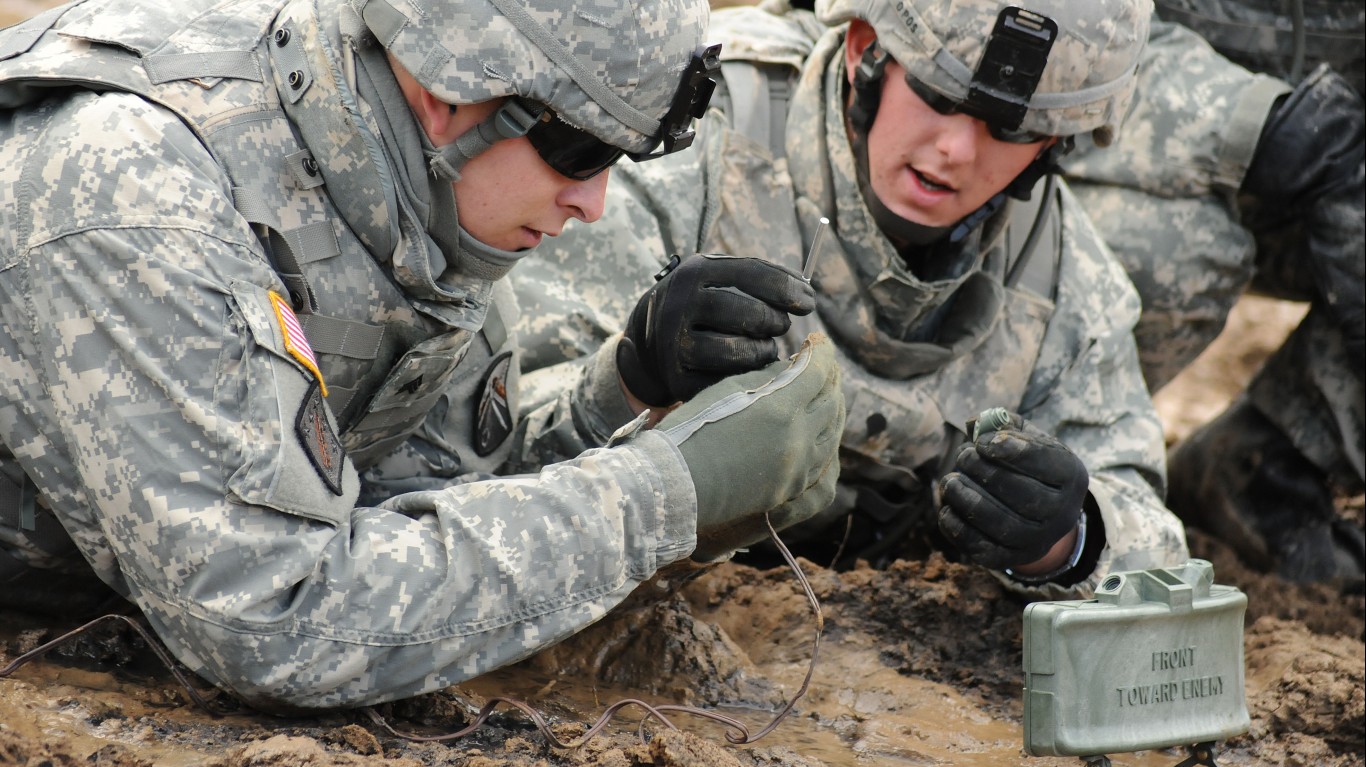
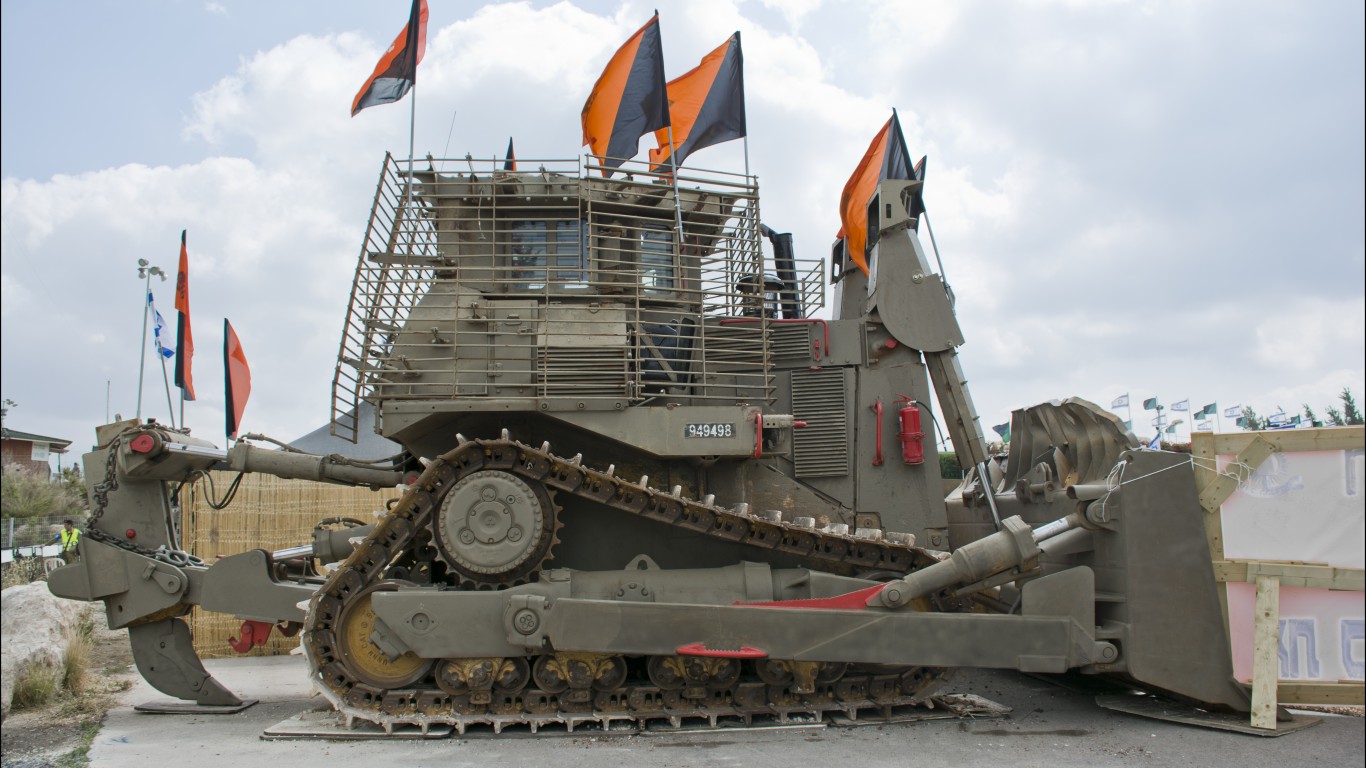
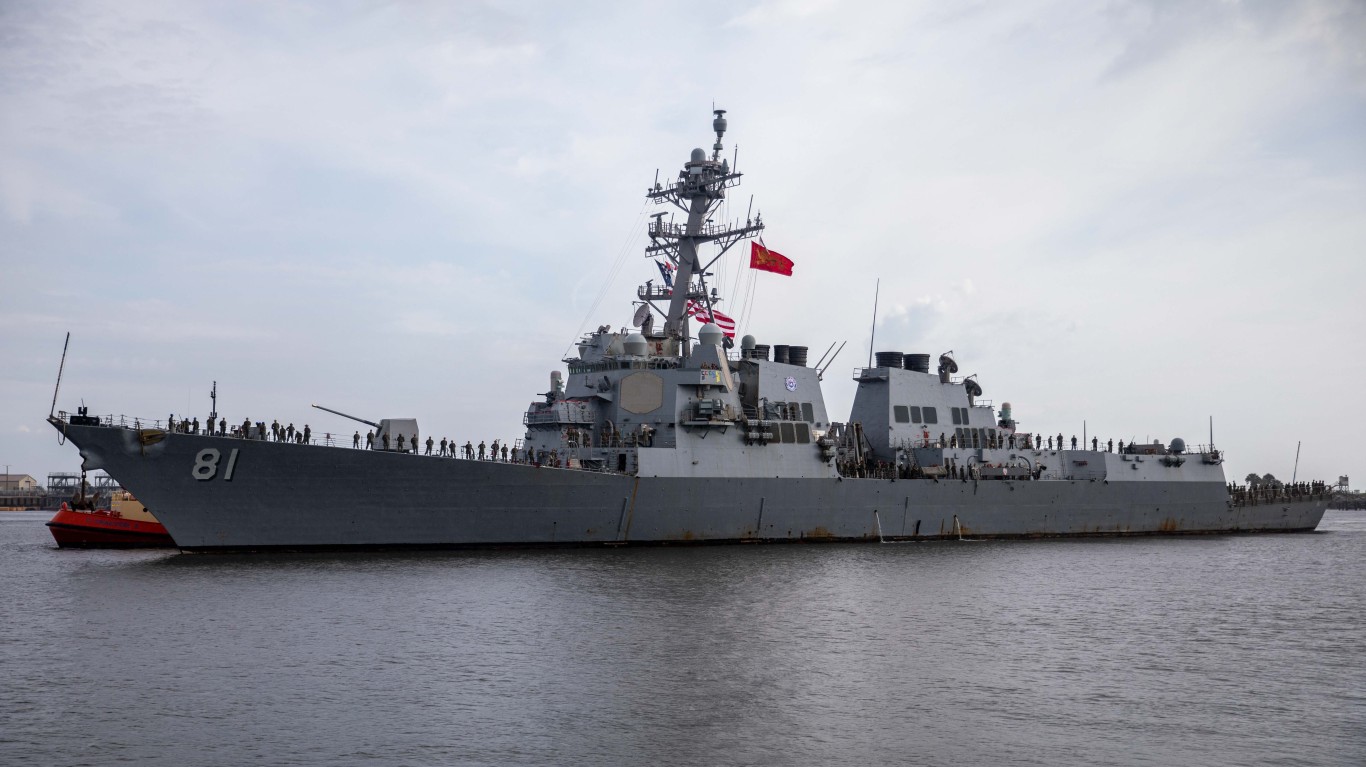 24/7 Wall St.
24/7 Wall St.
